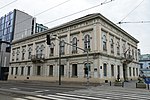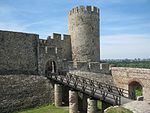Kalemegdan Park

The Kalemegdan Park (Serbian: Калемегдански парк / Kalemegdanski park), or simply Kalemegdan (Serbian Cyrillic: Калемегдан) is the largest park and the most important historical monument in Belgrade. It is located on a 125-metre-high (410 ft) cliff, at the junction of the River Sava and the Danube. Kalemegdan Park, split in two as the Great and Little Parks, was developed in the area that once was the town field within the Belgrade Fortress. Today residents often erroneously refer to the entire fortress as the Kalemegdan Fortress or just Kalemegdan, even though the park occupies the smaller part, especially of the historical fortress, and it is some two millennia younger. The fortress, including the Kalemegdan, represents a cultural monument of exceptional importance (from 1979), the area where various sport, cultural and arts events take place, for all generations of Belgraders and numerous visitors of the city.
Excerpt from the Wikipedia article Kalemegdan Park (License: CC BY-SA 3.0, Authors, Images).Kalemegdan Park
Мали Калемегдан, Belgrade Old Town (Stari Grad Urban Municipality)
Geographical coordinates (GPS) Address Nearby Places Show on map
Geographical coordinates (GPS)
| Latitude | Longitude |
|---|---|
| N 44.822593 ° | E 20.453066 ° |
Address
Кошаркашки клуб Црвена звезда
Мали Калемегдан 2
11000 Belgrade, Old Town (Stari Grad Urban Municipality)
Central Serbia, Serbia
Open on Google Maps











